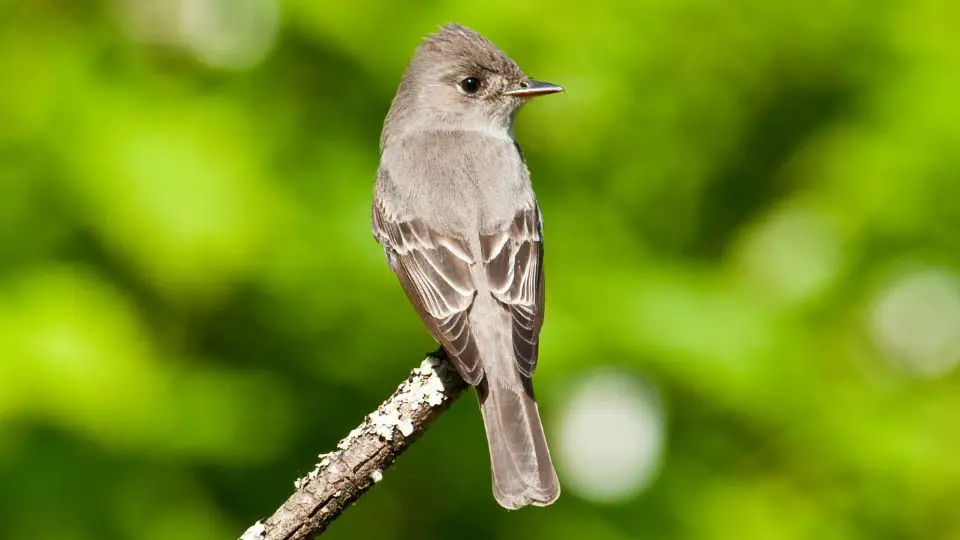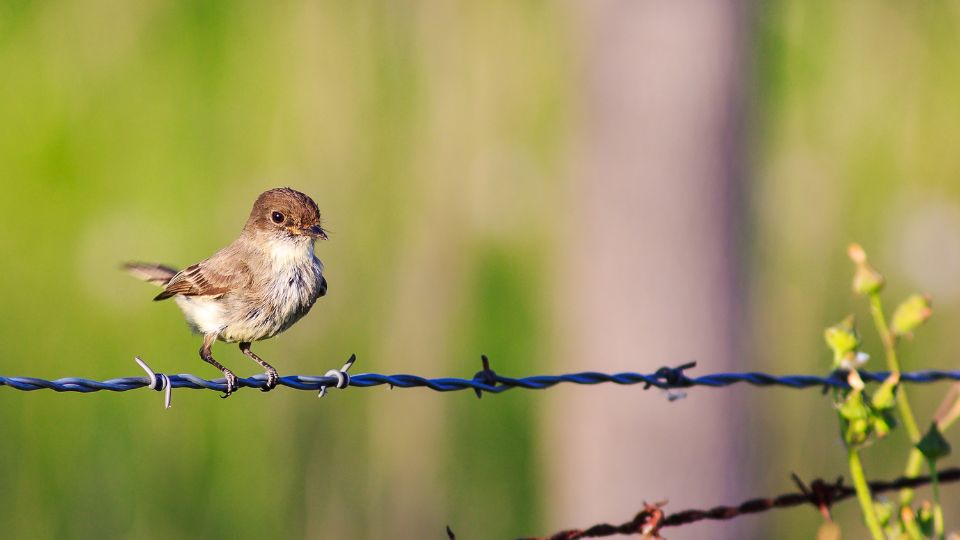Western and Eastern wood pewees reside on either coast of the US, and as long-distance migrators travel yearly to Central America and other tropical countries. They build their tiny nests very high up, have mysterious mating rituals, and are mostly heard than seen. You can tell both apart by their distinct calls.
Pewees are masters of disguise, so spotting one is quite tricky! They reside in lush forests and pines and make nests so inconspicuously that they can easily be confused by the bark of a tree. Pewees are small gray birds that prefer coniferous forests or deciduous forests. The Eastern and Western pewee is the most common subspecies in the United States.
Although they reside on different coastlines, they look almost identical. Pewees are gray birds with black wing bars and dark black eyes. They are about the size of a house sparrow and are a member of the tyrant flycatchers family. These long-distance migrants are tricky to spot, so knowing their mating rituals, songs, coloring, and migration patterns is critical to finding them!
Eastern Wood Pewees vs Western Wood Pewees
These types of wood pewees have a lot in common, but there are very subtle differences between the two. Both birds are similar in size (about the size of a house sparrow) with a similar wingspan of 25 centimeters. Overall, the Eastern wood-pewee is lighter in color, with a whitish olive green chest and more white accents in its wing bars. In addition to olive green accents, it has a touch of cinnamon orange on its lower mandible. It also has a white eye ring around its dark eyes, which is something that a Western wood-pewee does not have.

On the other hand, Western wood pewees are much darker in color, with a grayish coloring on their head and underparts, and darker black accents on their wing bars. While the differences are subtle, the Western wood-pewee doesn’t have olive green accents, and their overall coloring is much darker.

Even for the skilled birder, telling the difference between these two very similar birds is challenging. Luckily, their range map does not overlap. Western and Eastern pewees stick to their dedicated breeding range and are never found together. If you are even in doubt, their songs are pretty different. You can tell them apart by listening to their different calls. The Eastern wood-pewee has a distinctly sharp pee-a-wee call, while the Western wood-pewee sings a much different muddy pee-er or pee-wee song.
Habitat and Diet
Western wood pewees and Eastern coast pewees may live on different coasts, but their habitats are very similar. Both pewees prefer the lush, dense cover of thick forests. Eastern wooded pewees (aka Contopus virens) primarily reside in deciduous and conifer forests and will make their home in orchards in the Great Plains. On the other hand, Western wooded pewees don’t often live in thick forests. Instead, they reside in less wooded areas on forest edges and near a good water source.
Pewees are members of the tyrant flycatcher family, and their diet consists mainly of insects, but they will also eat berries. The pewees have an insect-rich diet that consists primarily of flying insects like wasps, flies, beetles, and moths, and they also eat the occasional caterpillar.
Mating, Nesting, and Eggs
Male pewees are members of the dawn chorus, but their active singing isn’t to attract a mate. There is little known about the mating rituals of pewees, but many believe that the male attracts a female by chasing her down in the branches of the treetops. Once a female selects a mate and a nesting site, she alone, builds her incredibly compact and fascinating nest.
Pewee nests are situated high in the treetops, with an average range between 15 and 45 feet! Nests are tiny and, at a glance, appear much too small even for these petite songbirds. Nests are made from spider webs and plant fibers, and the outside is decorated with lichens that make them effortlessly blend in with the tree bark to protect nestlings and fledglings from predators.
Females lay, on average, three eggs per clutch. On a rare occasion, she may lay up to four, but the nest is so tiny it cannot accommodate any more. While the female incubates the nest, the male pewee helps by bringing her food. Eggs take around two weeks to hatch.
Nestlings, Fledglings, and Juvenile Pewees
Once the eggs hatch, both parents take an active role in raising their young. The male and female deliver freshly-caught insects and return them to the nest to young pewees. After 18 days, the nestlings will graduate to fledglings and begin to leave the nest. Young Pewees look very similar to female pewees, with much more muted tones and coloring as their feathers develop. An easy way to tell the difference between a juvenile and a female Pewee is to observe their behavior. Juveniles are meek and timid and follow their parents and flutter their feathers as they wait for a meal.
Geography and Range of Migration
These long-distance migratory songbirds spend the breeding season in the forests of the United States and then migrate south to South America for their wintering grounds. Western and Eastern pewees breed in parts of the United States and Canada and arrive at their breeding grounds in late spring, often in the later part of April or early May. Their arrival times vary; some pewees don’t build their first nest until late May or early June. They leave for their wintering grounds in early September when the breeding season is over.
Unlike other migratory birds, the pewee doesn’t travel in a large flock. Pewees can become quite aggressive when traveling with other birds, especially ones in the tyrant flycatcher family. If other birds (that compete for food sources) get too close, pewees aggressively snap their bills to keep small flycatchers away.

Vocal Repertoire: Songs, Calls, and Sounds
Male pewees are enthusiastic members of the dawn chorus, they start singing well before the sun rises and continue to sing throughout the day. The Eastern wood-pewee call is loud and piercing and sounds like a sharp pee-a-wee call that lasts only a second, while the Western wood-pewee call is muddy and slurred. While other songbirds sing to attract a mate, aggressive pewees sing to defend their territory and keep other male pewees away. Their vocalizations are sharp and dramatic and are the hallmark of summer for residents living near pewee breeding grounds.
Pewees emit a sharp bzew, pee-wee, or chirp when other birds get too close to their territory. These aggressive songbirds will even snap their beaks at other Passeriformes that may compete with them for food sources.

